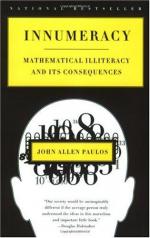
|
| Name: _________________________ | Period: ___________________ |
This test consists of 5 multiple choice questions, 5 short answer questions, and 10 short essay questions.
Multiple Choice Questions
1. What did the Italian scientist discover?
(a) Combustible fuel.
(b) Pluto.
(c) Bubonic plague.
(d) Atom.
2. What item helps mathematical illiterates understand the above theory?
(a) Subsets.
(b) Division.
(c) Multiplication.
(d) Exponents.
3. What number is used in the joke about the population of the city?
(a) 1,000.
(b) 6.
(c) 120.
(d) 18.
4. Which group does this coincidence often apply to?
(a) Seniors.
(b) Children.
(c) Taxi drivers.
(d) Gamblers.
5. Paulos believes that most people fall where in their mathematical understanding?
(a) Lower quadrant.
(b) Bottom 10%.
(c) Top 10%.
(d) Middle.
Short Answer Questions
1. Where do the two people meet?
2. What theory states that any number, no matter how large, can be achieved by adding smaller numbers together?
3. What is the probability of people being directly linked?
4. What restaurant is referenced?
5. Which staff member is mentioned?
Short Essay Questions
1. What is the coincidence surrounding Christopher Columbus?
2. The first example Paulos uses about percentages relates to weather forecasters. What is the mistake?
3. Examine the first story told by Paulos in this chapter.
4. Where does the author believe most people fit in?
5. How does Paulos feel when people attempt to diagnose his personality by his astrological sign?
6. How was the situation in the story handled? How did it involve probability?
7. What is the last principle discussed in chapter 1?
8. The author believes that people are often obsessed by what topics?
9. Which famous doctor does Paulos introduce first? What is the doctor's opinion?
10. What is Paulos' suggestion for making math more understandable to the general public?
|
This section contains 494 words (approx. 2 pages at 300 words per page) |

|




